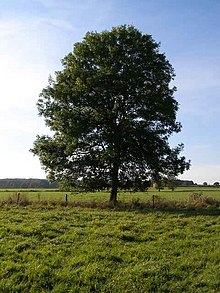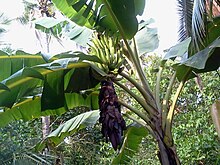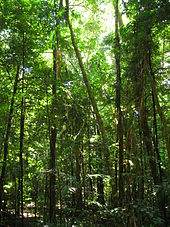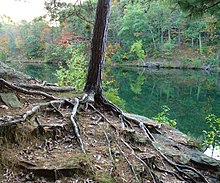From Wikipedia, the free encyclopedia
For other uses, see Tree (disambiguation).
Common ash (Fraxinus excelsior), a deciduous broad-leaved (angiosperm) tree
European larch (Larix decidua), a coniferous tree which is also deciduous
Lepidodendron, an extinct lycophyte tree
A tree typically has many secondary branches supported clear of the ground by the trunk. This trunk typically contains woody tissue for strength, and vascular tissue to carry materials from one part of the tree to another. For most trees it is surrounded by a layer of bark which serves as a protective barrier. Below the ground, the roots branch and spread out widely; they serve to anchor the tree and extract moisture and nutrients from the soil. Above ground, the branches divide into smaller branches and shoots. The shoots typically bear leaves, which capture light energy and convert it into sugars by photosynthesis, providing the food for the tree's growth and development. Flowers and fruit may also be present, but some trees, such as conifers, instead have pollen cones and seed cones; others, such as tree ferns, produce spores instead.
Trees play a significant role in reducing erosion and moderating the climate. They remove carbon dioxide from the atmosphere and store large quantities of carbon in their tissues. Trees and forests provide a habitat for many species of animals and plants. Tropical rainforests are one of the most biodiverse habitats in the world. Trees provide shade and shelter, timber for construction, fuel for cooking and heating, and fruit for food as well as having many other uses. In parts of the world, forests are shrinking as trees are cleared to increase the amount of land available for agriculture. Because of their longevity and usefulness, trees have always been revered and they play a role in many of the world's mythologies.
Contents
Definition
Diagram of secondary growth in a eudicot or coniferous tree showing idealised vertical and horizontal sections. A new layer of wood is added in each growing season, thickening the stem, existing branches and roots.
A commonly applied narrower definition is that a tree has a woody trunk formed by secondary growth, meaning that the trunk thickens each year by growing outwards, in addition to the primary upwards growth from the growing tip.[5][8] Under such a definition, herbaceous plants such as palms, bananas and papayas are not considered trees regardless of their height, growth form or stem girth. Certain monocots may be considered trees under a slightly looser definition;[9] while the Joshua tree, bamboos and palms do not have secondary growth and never produce true wood with growth rings,[10][11] they may produce "pseudo-wood" by lignifying cells formed by primary growth.[12]
Aside from structural definitions, trees are commonly defined by use, for instance as those plants which yield lumber.[13]
Overview
The tree growth habit is an evolutionary adaptation found in different groups of plants: by growing taller, trees are able to compete better for sunlight.[14] Trees tend to be long-lived,[15] some reaching several thousand years old, as well as tall.[16] Trees have modified structures such as thicker stems composed of specialized cells that add structural strength and durability, allowing them to grow taller than non-woody plants and to spread out their foliage. They differ from shrubs, which are also woody plants, by usually growing larger and having a single main stem;[6] but the distinction between a small tree and a large shrub is not always clear,[17] made more confusing by the fact that trees may be reduced in size under harsher environmental conditions such as on mountains and subarctic areas. The tree form has evolved separately in unrelated classes of plants in response to similar environmental challenges, making it a classic example of parallel evolution. With an estimated 100,000 species, the number of trees worldwide might total twenty-five percent of all living plant species.[18] The greatest number of these grow in tropical regions and many of these areas have not yet been fully surveyed by botanists, making tree diversity and ranges poorly known.[19]
Tall herbaceous monocotyledonous plants such as banana lack secondary growth, and are trees only in a loose sense.
Wood gives structural strength to the trunk of a tree; this supports the plant as it grows larger. The vascular system of trees allows water, nutrients and other chemicals to be distributed around the plant, and without it trees would not be able to grow as large as they do. Trees, as relatively tall plants, need to draw water up the stem through the xylem from the roots by the suction produced as water evaporates from the leaves. If insufficient water is available the leaves will die.[22] The three main parts of trees include the root, stem, and leaves; they are integral parts of the vascular system which interconnects all the living cells. In trees and other plants that develop wood, the vascular cambium allows the expansion of vascular tissue that produces woody growth. Because this growth ruptures the epidermis of the stem, woody plants also have a cork cambium that develops among the phloem. The cork cambium gives rise to thickened cork cells to protect the surface of the plant and reduce water loss. Both the production of wood and the production of cork are forms of secondary growth.[23]
Trees are either evergreen, having foliage that persists and remains green throughout the year,[24] or deciduous, shedding their leaves at the end of the growing season and then having a dormant period without foliage.[25] Most conifers are evergreens but larches (Larix and Pseudolarix) are deciduous, dropping their needles each autumn, and some species of cypress (Glyptostrobus, Metasequoia and Taxodium) shed small leafy shoots annually in a process known as cladoptosis.[6] The crown is a name for the spreading top of a tree including the branches and leaves,[26] while the uppermost layer in a forest, formed by the crowns of the trees, is known as the canopy.[27] A sapling is a young tree.[28]
Many tall palms are herbaceous[29] monocots; these do not undergo secondary growth and never produce wood.[10][11] In many tall palms, the terminal bud on the main stem is the only one to develop, so they have unbranched trunks with large spirally arranged leaves. Some of the tree ferns, order Cyatheales, have tall straight trunks, growing up to 20 metres (66 ft), but these are composed not of wood but of rhizomes which grow vertically and are covered by numerous adventitious roots.[30]
Distribution
Further information: Forest
The number of trees in the world, according to a 2015 estimate, is 3.04 trillion, of which 1.39 trillion (46%) are in the tropics or sub-tropics, 0.61 trillion (20%) in the temperate zones, and 0.74 trillion (24%) in the coniferous boreal forests.
The estimate is about eight times higher than previous estimates, and
is based on tree densities measured on over 400,000 plots. It remains
subject to a wide margin of error, not least because the samples are
mainly from Europe and North America.
The estimate suggests that about 15 billion trees are cut down annually
and about 5 billion are planted. In the 12,000 years since the start of
human agriculture, the number of trees worldwide has decreased by 46%.[31][32][33]
The Daintree rainforest
In cool temperate regions, conifers often predominate; a widely distributed climax community in the far north of the northern hemisphere is moist taiga or northern coniferous forest (also called boreal forest).[36][37] Taiga is the world's largest land biome, forming 29% of the world's forest cover.[38] The long cold winter of the far north is unsuitable for plant growth and trees must grow rapidly in the short summer season when the temperature rises and the days are long. Light is very limited under their dense cover and there may be little plant life on the forest floor, although fungi may abound.[39] Similar woodland is found on mountains where the altitude causes the average temperature to be lower thus reducing the length of the growing season.[40]
Where rainfall is relatively evenly spread across the seasons in temperate regions, temperate broadleaf and mixed forest typified by species like oak, beech, birch and maple is found.[41] Temperate forest is also found in the southern hemisphere, as for example in the Eastern Australia temperate forest, characterized by Eucalyptus forest and open acacia woodland.[42]
In tropical regions with a monsoon or monsoon-like climate, where a drier part of the year alternates with a wet period as in the Amazon rainforest, different species of broad-leaved trees dominate the forest, some of them being deciduous.[43] In tropical regions with a drier savanna climate and insufficient rainfall to support dense forests, the canopy is not closed, and plenty of sunshine reaches the ground which is covered with grass and scrub. Acacia and baobab are well adapted to living in such areas.[44]
Parts and function
A young red pine (Pinus resinosa) with spread of roots visible, as a result of soil erosion
Roots
Main article: Root
The roots of a tree serve to anchor it to the ground and gather water
and nutrients to transfer to all parts of the tree. They are also used
for reproduction, defence, survival, energy storage and many other
purposes. The radicle or embryonic root is the first part of a seedling to emerge from the seed during the process of germination. This develops into a taproot which goes straight downwards. Within a few weeks lateral roots
branch out of the side of this and grow horizontally through the upper
layers of the soil. In most trees, the taproot eventually withers away
and the wide-spreading laterals remain. Near the tip of the finer roots
are single cell root hairs. These are in immediate contact with the soil particles and can absorb water and nutrients such as potassium in solution. The roots require oxygen to respire and only a few species such as the mangrove and the pond cypress (Taxodium ascendens) can live in permanently waterlogged soil.[45]In the soil, the roots encounter the hyphae of fungi. Many of these are known as mycorrhiza and form a mutualistic relationship with the tree roots. Some are specific to a single tree species, which will not flourish in the absence of its mycorrhizal associate. Others are generalists and associate with many species. The tree acquires minerals such as phosphorus from the fungus while it obtains the carbohydrate products of photosynthesis from the tree.[46] The hyphae of the fungus can link different trees and a network is formed, transferring nutrients from one place to another. The fungus promotes growth of the roots and helps protect the trees against predators and pathogens. It can also limit damage done to a tree by pollution as the fungus accumulate heavy metals within its tissues.[47] Fossil evidence shows that roots have been associated with mycorrhizal fungi since the early Paleozoic, four hundred million years ago, when the first vascular plants colonised dry land.[48]
Some trees such as the alders (Alnus species) have a symbiotic relationship with Frankia species, a filamentous bacterium that can fix nitrogen from the air, converting it into ammonia. They have actinorhizal root nodules on their roots in which the bacteria live. This process enables the tree to live in low nitrogen habitats where they would otherwise be unable to thrive.[49] The plant hormones called cytokinins initiate root nodule formation, in a process closely related to mycorrhizal association.[50]
Buttress roots of the kapok tree (Ceiba pentandra)
The roots are, generally, an underground part of the tree, but some tree species have evolved roots that are aerial. The common purposes for aerial roots may be of two kinds, to contribute to the mechanical stability of the tree, and to obtain oxygen from air. An instance of mechanical stability enhancement is the red mangrove that develops prop roots that loop out of the trunk and branches and descend vertically into the mud.[52] A similar structure is developed by the Indian banyan.[53] Many large trees have buttress roots which flare out from the lower part of the trunk. These brace the tree rather like angle brackets and provide stability, reducing sway in high winds. They are particularly prevalent in tropical rainforests where the soil is poor and the roots are close to the surface.[54]
Some tree species have developed root extensions that pop out of soil, in order to get oxygen, when it is not available in the soil because of excess water. These root extensions are called pneumatophores, and are present, among others, in black mangrove and pond cypress.[52]
Trunk
Northern beech (Fagus sylvatica) trunk in autumn
Main article: Trunk (botany)
The main purpose of the trunk is to raise the leaves above the
ground, enabling the tree to reach the light and survive: the tree can
overtop other plants and shade them out. It also performs the task of
transporting water and nutrients from the roots to the aerial parts of
the tree and to distribute the food produced by the leaves to all other
parts including the roots.[55]In the case of angiosperms and gymnosperms, the outermost layer of the trunk is the bark and is mostly composed of dead cells. It provides a thick, waterproof covering to the living inner tissue. It protects the trunk against the elements, disease, animal attack and fire. It is perforated by a large number of fine breathing pores called lenticels, through which oxygen diffuses. Bark is continually replaced by a living layer of cells called the cork cambium. The London plane (Platanus × acerifolia) periodically sheds its bark in large flakes. Similarly, the bark of the silver birch (Betula pendula) peels off in strips. As the tree's girth expands, newer layers of bark are larger in circumference, and the older layers develop fissures in many species. In some trees such as the pine (Pinus species) the bark exudes sticky resin which deters attackers whereas in rubber trees (Hevea brasiliensis) it is a milky latex that oozes out. The quinine bark tree (Cinchona officinalis) contains bitter substances to make the bark unpalatable.[55] Large tree-like plants with lignified trunks in the Pteridophyta, Arecales, Cycadophyta and Poales such as the tree ferns, palms, cycads and bamboos have no true bark, but they do have an outer protective covering of some form.[56]
Although the bark functions as a protective barrier, it is itself attacked by boring insects such as beetles. These lay their eggs in crevices and the larvae chew their way through the cellulose tissues leaving a gallery of tunnels. This may allow fungal spores to gain admittance and attack the tree. Dutch elm disease is caused by a fungus (Ophiostoma species) carried from one elm tree to another by various beetles. The tree reacts to the growth of the fungus by blocking off the xylem tissue carrying sap upwards and the branch above, and eventually the whole tree, is deprived of nourishment and dies. In Britain in the 1990s, 25 million elm trees were killed by this disease.[57]
The innermost layer of bark is known as the phloem and this is involved in the transport of the sap containing the sugars made by photosynthesis to other parts of the tree. It is a soft spongy layer of living cells, some of which are arranged end to end to form tubes. These are supported by parenchyma cells which provide padding and include fibres for strengthening the tissue.[58] Inside the phloem is a layer of undifferentiated cells one cell thick called the vascular cambium layer. The cells are continually dividing, creating phloem cells on the outside and wood cells known as xylem on the inside.[59]
The newly created xylem is the sapwood. It is composed of water-conducting cells and associated cells which are often living, and is usually pale in colour. It transports water and minerals from the roots to the upper parts of the tree. The oldest, inner part of the sapwood is progressively converted into heartwood as new sapwood is formed at the cambium. The conductive cells of the heartwood are blocked in some species, and the surrounding cells are more often dead. Heartwood is usually darker in colour than the sapwood. It is the dense central core of the trunk giving it rigidity. Three quarters of the dry mass of the xylem is cellulose, a polysaccharide, and most of the remainder is lignin, a complex polymer. A transverse section through a tree trunk or a horizontal core will show concentric circles or lighter or darker wood - tree rings. These rings are the annual growth rings[60] There may also be rays running at right angles to growth rings. These are vascular rays which are thin sheets of living tissue permeating the wood.[61] Many older trees may become hollow but may still stand upright for many years.[62]
 07:49
07:49













No comments
Post a Comment